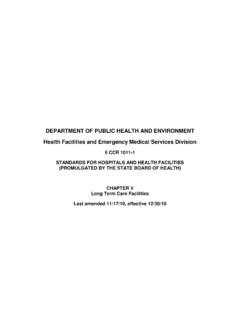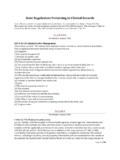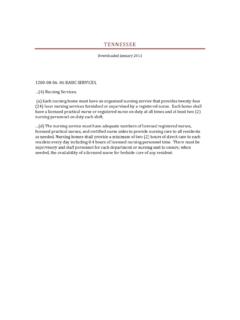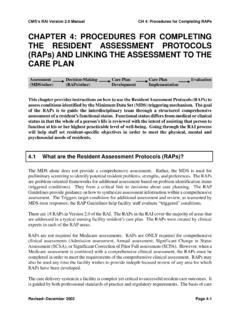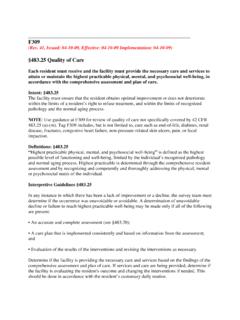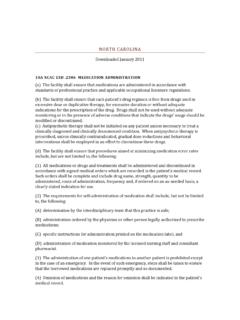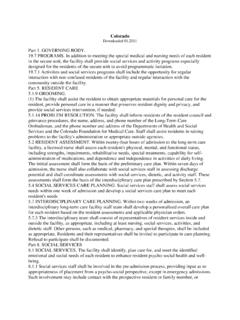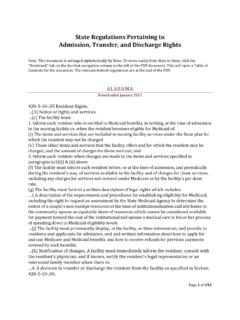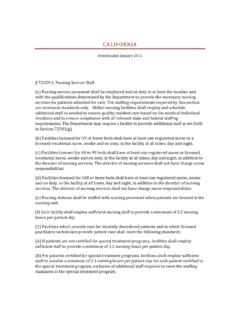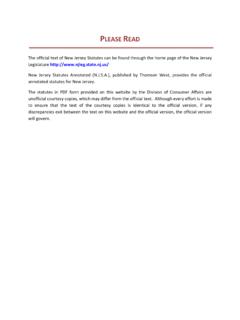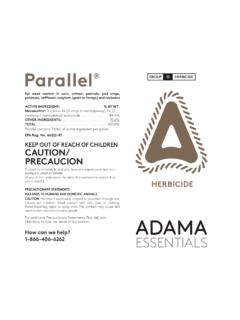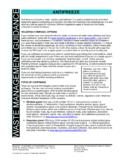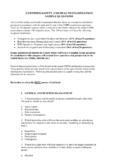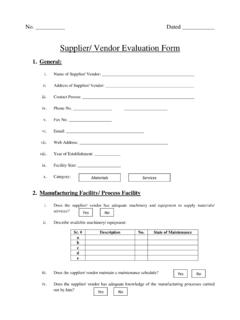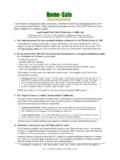Transcription of State Rules and Regulations Pertaining to Nurses …
1 State Rules and Regulations Pertaining to Nurses Aide training and Competency Note: This document is arranged alphabetically by State . To move easily from State to State , click the Bookmark tab on the Acrobat navigation column to the left of the PDF document. This will open a Table of Contents for the document. The relevant federal Regulations are at the end of the PDF. ALABAMA. Downloaded January 2011. Administrative Management. (8) Required training of nursing aides - Definition. Licensed health professional means a physician; physician assistant; nurse practitioner; physical, speech, or occupational therapist; physical or occupational therapy assistant; registered professional nurse .
2 Licensed practical nurse ; licensed or certified social worker, or dietitians. nurse aide means any individual providing nursing related services to residents in a facility who is not a licensed health professional, a registered dietitian, or someone who volunteers to provide such services without pay. (9) General rule. A facility must not use any individual working in the facility as a nurse aide for more than four months, on a full-time basis, unless: (a) That individual is competent to provide nursing related services; and (b) That individual has completed a training and competency evaluation program; or (c) That individual has been deemed or determined competent by the Alabama nurse Aide Registry.
3 (10) Non-permanent employees. A facility must not use on a temporary, per diem, leased, or any basis other than a permanent employee any individual who does not meet the requirements in paragraphs b & c above as a nurse aide. (11) Competency. A facility must not use any individual who has worked less than four months as a nurse aide in that facility unless the individual: (a) Is a full-time employee in a State -approved training and competency evaluation program. (b) Has demonstrated competence through satisfactory participation in a State -approved nurse aide training and competency evaluation program; or (c) Has been deemed or determined competent by the Alabama nurse Aide Registry.
4 (12) Registry verification. Before allowing an individual to serve as a nurse aide, a facility must receive registry verification that the individual has met competency evaluation requirements unless: (a) The individual is a full-time employee in a training and competency evaluation program approved by the State ; or (b) The individual can prove that he or she has recently successfully completed a training and competency evaluation program approved by the State and has not yet been included in the registry. Facilities must follow up to ensure that such an individual actually becomes registered.
5 (13) Multi- State registry verification. Before allowing an individual to serve as a nurse aide, a facility must contact the Alabama nurse Aide registry to seek information from every State registry the facility believes includes information on the individual. (14) Required retraining. If, since an individual's most recent completion of a training and competency evaluation program, there has been a continuous period of 24 consecutive months during none of which the individual provided nursing-related services for monetary compensation, the individual must complete a new training and competency evaluation program.
6 (15) Regular in-service education. The facility must complete a performance review of every nurse aide at least once every 12 months, and must provide regular in-service education based on the outcome of these reviews. The in-service training must: (a) Be sufficient to ensure that continuing competence of nurse aides, but must be no less than 12 hours per year;. (b) Address areas of weakness as determined in nurse aides' performance reviews and may address the special needs of residents as determined by the facility staff; and (c) For nurse aides providing services to individuals with cognitive impairments, also address the care of the cognitively impaired.
7 (16) Proficiency of nurse Aides. The facility must ensure that nurse aides are able to demonstrate competency in skills and techniques necessary to care for residents' needs, as identified through resident assessments, and described in the plan of care. ALASKA. Downloaded January 2011. Alaska Regulations do not include specific content for nurse 's aide training and competency. ARIZONA. Downloaded January 2011. Arizona Regulations do not include specific content for nurse 's aide training and competency. ARKANSAS. Downloaded January 2011. 805 STAFF training .
8 A. In addition to any State or federal training requirements Pertaining to long term care facilities, each CNA working in a HomeStyle home shall complete the following eighty (80). hours of training to include but not limited to: training : HomeStyle Model v. Traditional Model HOURS: Activities- development of, and appreciation for, activities designed to meet the individual's personal preferences and needs. Replacing the medical model role of employees Disregarding the medical model role of residents Organizational Culture Change training : Universal/Flexible Worker HOURS : Concept Responsibilities of the Worker training : Person-directed Care HOURS: Concepts and Relationship Building Execution Documentation training : Self-Managed or Self-Directed Work Team HOURS: Concept Responsibilities Conflict Resolution and Learning Circles Staffing training : Food Safety HOURS.
9 Introduction Safety Contamination Allergies Therapeutic Diets Thickening Agents Food Preparation training : Family style dining HOURS: Concept Measuring intake Management Safety Documentation training : Emergency Situations and Evacuation HOURS: Fire Drills Tornado Drills Disaster Drills Evacuation Emergency Equipment (fire extinguishers, generators, water and gas shut-offs, etc.). Behavioral Issues Choking Emergency calls Environmental policy training : Cottage Equipment Use HOURS: Appliance Usage (microwave, vent-a-hood, stove, fryer, lifts, whirlpools, washer and dryers, air-conditioners, etc.)
10 Appliance Safety (changing grease, cleaning vent-a-hood, etc.). training :Cottage Orientation HOURS: Phone system Call system Cleaning Supply Storage Cleaning Supply Usage Workplace Organization training : Communication HOURS: Communication Skills Coaching Skills Accountability Support training Observation skills HOURS: How to obtain a history from family How to initiate a resident observation How a care plan is developed How to read a care plan How to modify a care plan How to identify a resident's change in condition 806 training APPROVAL. Each facility seeking designation as a HomeStyle facility shall provide to the Office of Long Term Care a syllabus, a list of required reference and study materials, and a proposed curriculum of training as required in Section 805.

